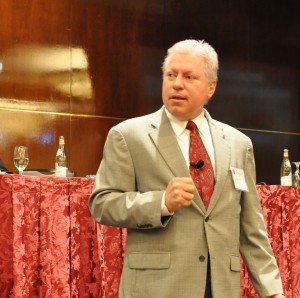Tap into emotions to deliver HSE message

By Katie Mazerov, contributing editor
Facts are important, but they don’t convey the emotional connection that can motivate people to change their behavior – a mind shift must occur when it comes to the critically important area of HSE training. That was the message delivered by Jack Frost, director of quality, health, safety, environment and security for Tesco Corp, at the IADC Health, Safety, Environment and Training Conference & Exhibition, 7-8 February in Houston. “Sometimes, information alone is not enough. People need an emotional experience for information to mean something,” Mr Frost said.
That philosophy is especially important with new-generation employees, he believes. “Because of their experiences with video games and 3D television, young people coming into the industry today are more sensory-oriented, and therefore we must provide them with a sensory-based experience in learning.”
With that in mind, Mr Frost advocates a whole-brain approach that combines the logic and linearity of the left brain with the emotion, passion and imagery of the right brain to create an emotional connection to HSE. “For example, when we talk about our first-quartile HSE performance, I believe only 40% has to do with process, policies and procedures,” he said. “The vast majority has to do with culture, attitude and mindset to drive those processes. Otherwise, all we have are manuals that collect dust.”
A strong HSE culture requires increasing commitment and personal responsibility through a step-by-step process of management, involvement and cooperation and continuous improvement, culminating in what Mr Frost calls flash points. “Flash points occur when we have good people working hard and working smart, and suddenly everything just comes together and performance is catapulted to the next level.”
A five-point system
He recommends companies follow five key steps to communicate the importance of HSE:
- Keep it simple: Find the core idea of your HSE culture message, then establish a step-by-step process. Strive to hold everyone’s attention.
- Add an element of surprise: “Through the years, we have all developed patterns in our head about delivering presentations and how to communicate,” Mr Frost said. “But we need to interrupt that pattern and do something that will be remembered. People remember the unexpected.”
- Convey emotion: “Deliver a message in an emotional way to create a connection and meaning to go to the next level. It creates a different level of awareness,” he said.
- Make it real: Make people aware of why they need a strong HSE culture. People don’t need to know all the applications and intricacies, but they must receive a clear, simple and concrete message. “Avoid the Darth Vader element – the curse of knowledge,” Mr Frost said. “Know who you are talking to. If a person with a lot of expertise is using language that a novice doesn’t understand, that can create a disconnect.”
- Tell stories: Personal anecdotes and stories can communicate information in a meaningful way and with more impact.
“As an industry, as an association and as companies, we have to pick a lane,” Mr Frost said. “Developing a strong HSE culture means making the proactive decision to make that commitment.”




